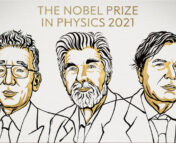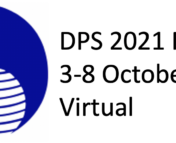Title: An astronomical institute’s perspective on meeting the challenges of the climate crisis
Authors: Knud Jahnke, Christian Fendt, Morgan Fouesneau, Iskren Georgiev, Tom Herbst, Melanie Kaasinen, Diana Kossakowski, Jan Rybizki, Martin Schlecker, Gregor Seidel, Thomas Henning, Laura Kreidberg and Hans-Walter Rix
First Author’s Institution: Max Planck Institute for Astronomy, Heidelberg, Germany
Status: Published in Nature Astronomy
We have some serious thinking to do about our relationship to climate change as astronomers. Everyone has an impact on the climate through the ways we live our lives: our methods of transportation, our hobbies, how we eat, and certainly our choice of profession. It’s convenient to measure the net sum of this impact with a number: our effective greenhouse gas emissions, also known as our carbon footprint.
Our carbon footprint is a measure of how much carbon dioxide (CO2) we release into the Earth’s atmosphere. This can include everything from the burning of fossil fuels by the cars we drive and the airplanes we ride to the electricity we consume and the goods we purchase. Members of certain professions can contribute a disproportionate percentage of greenhouse gas emissions. Astronomy is one such field, as pointed out in this recent bite and by the 2020 Decadal Survey (the recently released report outlining the priorities of the US astronomy community). Given the international nature of our work and the magnitude of computational resources we require, we should carefully consider how our research is affecting climate change.
Today’s paper, part of a series focused on climate change in Nature Astronomy, answers some really important questions regarding astronomers’ carbon footprint: how many tons (yes, metric tons, it’s a lot…) of CO2 are astronomers producing every year, and which practices are responsible for these emissions? How does this compare between different countries and institutes? And how can we work towards a more sustainable future for our field – one where we can treasure and revel in the wonders of space while responsibly preserving our one and only oasis in the void?
The authors of today’s paper focus on one particular research institute: the Max Planck Institute for Astronomy (MPIA) in Heidelberg, Germany. While the results presented are specific to MPIA, they compare them with the results of a similar study of the emissions from Australian astronomers. The authors also suggest that their work could be used as a template for assessing the impact of other institutes.
Starting with the question of CO2, today’s authors find that MPIA astronomers generate an average of 18.1 tons of CO2 per year per researcher, as compared to the 41.8 tons of CO2 per year for each Australian astronomer. Where are all these greenhouse gases coming from? And why is there such a stark difference between these countries? In this bite, we will take a look at some of the dominant sources of astronomers’ CO2 emissions and briefly consider how their impact might be reduced in the future.
Supercomputers or Super-polluters?
More and more, astronomy research has become computationally expensive. Why? Data sets are getting bigger and bigger, requiring more and more computer resources to analyze them. In particular, running the powerful supercomputers needed to perform cutting edge theoretical research and supply the growing number of computational astrophysicists requires energy. A LOT of energy. A recent study looking at the emissions from Australian astronomers revealed some grim news about the enormous impact of high performance computing on the environment. Taking into account the electricity required to run (and keep cool!) national supercomputing resources as well as individually owned local computers, the paper shows that computing generates effective emissions of 22 tons of CO2 per astronomer per year in Australia. That’s a lot of emissions!
The supercomputing emissions per research at the MPIA is a bit more hopeful, but still results in ~5 tons CO2 per astronomer per year (see Figure 1). The difference is almost entirely due to differences in the use of renewable energy of the electrical grids between Australia and Germany. Clearly, the nature of the electrical grid powering the supercomputing clusters we use makes a huge difference! While it might be hard to individually change the nature of energy production in our countries, there’s a real and urgent need for the astronomy community to advocate for a significant decrease in the use of fossil fuels to power the resources we use!
One option suggested by the authors is to develop supercomputing facilities in locations where renewable energy sources are well developed and cheaper, such as the largely geothermal electrical grid in Iceland (check out this awesome map of the sustainability of electrical grids around the world). Researchers around the world could pool resources to construct and support new centers, allowing us to continue cutting edge numerical simulation and data analysis without excess damage to our environment.
The Carbon Cost of Conferences
One of the great joys of astronomy is how much collaboration occurs across borders. However, working closely and sharing results with scientists around the world poses a significant environmental problem when it comes to travel. Air travel is extremely costly in terms of greenhouse gas emissions, and both MPIA and the Australian astronomy community find that flights to and from international conferences are a huge component of their effective emissions. The most carbon-expensive of those flights are intercontinental trips which cannot be replaced by ground travel (see Figure 2 for the breakdown). This problem is certain to be worse in countries that have severely limited public transportation infrastructure for long-distance travel (looking at you, USA).
So what do we do about this? There just isn’t a clear way to make these large international conferences less environmentally costly. It’s possible to calculate the “carbon offset” price of your travel and make an equivalent donation towards environmental sustainability, but universities won’t reimburse this extra cost and younger career scientists can’t be expected to pay extra money from their already very limited stipends. So the solution might be to just not go to as many international conferences. One of the potential silver linings of our present global pandemic is that the astronomy community was forced to realize that virtual conferences are very possible. We could steer our community towards supporting hybrid or online conferences that encourage sustainability and accessibility while hosting more local conferences to give early-career scientists the chance to network and find local collaborations more easily.
Other Sources of Emissions
In addition to flights and high performance computing, running observatories also contributes significantly to the carbon cost of astronomy research, (the rightmost gray segment of Australia’s emissions breakdown in Figure 1), as does the heating of buildings, sourcing of electronics, and daily commuting. However, travel and electricity for computing remain the biggest immediate challenges for our community. We cannot hope to meet the emission goals set by the UN to limit the planet’s warming until these problems are addressed.
More Coming Soon from the Climate Change Series
There’s a lot more to be said about each of these emission sources, and a lot more will be said! Coming soon from the Astrobites Climate Change Series are dedicated articles on high performance computing, alternatives to in-person international conferences, the details of telescope operations, and tons more! It’s important to come face-to-face with the environmental cost of astronomy, but we hope these articles will also highlight the path forward, and motivate us all as a community to advocate for a sustainable future for our field.
This article was written as a part of our Climate Change Series. We’d love to hear what you would like to see from this initiative – if you have ideas, please let us know in this google form.
Astrobite edited by Alice Curtin and Olivia Cooper
Featured image credit: Berlin at night, ESA/NASA




